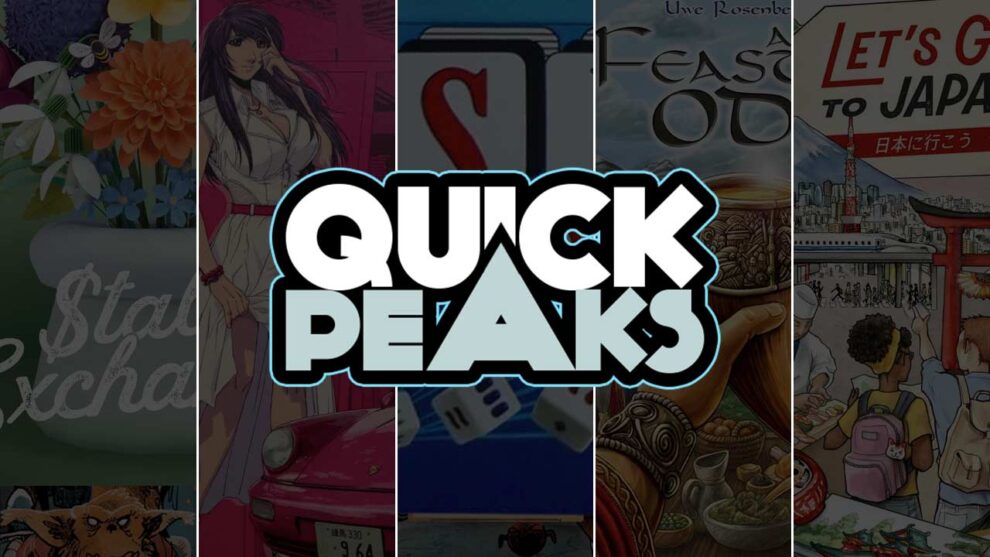Stalk Exchange – Andy Matthews
While I was at GAMA Expo 2024, I had the opportunity to preview and even play many games that will be released this year. But my absolute favorite of the show was Stalk Exchange, from TheOP. It was the only game that I came back to after walking the floor, because I wanted to see more of it. TheOP was kind enough to send me a copy for review, so I’m giving you a sneak peek at this one because it’s worth looking into.
Stalk Exchange is a market manipulation game, loosely set in the Dutch tulip bubble of the early 1600s. In this game players attempt to earn the most money by forecasting the value of 5 different types of flowers, then planting and harvesting those flowers in order to manipulate the value of those same flowers. Mechanically speaking it’s a very simple game: you plant flowers from the market, or you swap your private collection with what’s in the market. Flowers are planted bulb side up, and then bloom once the bulb has open spaces around it. Flowers are harvested once they’re completely surrounded by other flowers, bulbs, or the sides of the board. As flowers are harvested they’re placed onto the main board to increase the value of the harvested flowers. When a flower value marker meets a flower on the main track, the game ends.
Even though gameplay is simple, there’s a lot of thought which goes into placement and timing. You need to closely monitor the current value of the various flowers because at the end of the game you’ll receive points equal to the total number of flowers you have times each flower’s current value. But the catch is that at the game’s end the flower(s) with the highest value have their value cut in half. So you also have to keep track of that and make plans accordingly. All in all Stalk Exchange is excellent, and a great example of this type of game.
Select one item from each group below. Delete this line.
Ease of entry?:
★★★★☆ – The odd bump or two
Would I play it again?:
★★★★★ – Will definitely play it again
Read more articles from Andy Matthews.
My Favorite Carrera RS Trick Taking Game – Justin Bell
Originally released in 2014 and currently so hot it can only be found on the trick-taking black market, My Favorite Carrera RS Trick Taking Game (based on a Japanese manga of the same name) might be the strangest game I have played—or will play—this year. Given that I have played an abstract puzzle game reskinned with Pac-Man, an 18xx party game where one of the privates allows a player to become an oceanographer, and a card game featuring a polar bear playing a rainbow-colored guitar-xylophone hybrid on the cover, I think that is saying something!
My Favorite Carrera is a “must NOT follow” trick-taking game where players are trying to win the last trick in a six-trick round to earn a trophy. Whoever earns two trophies first is the winner. To win tricks, you need to play the highest card…but there are so many rules regarding how cards can win, lose, get zeroed out, boosted by “momentum”, and aided by “fuel” that the rules overhead makes My Favorite Carrera one of the hardest-to-teach trick-takers I have ever played. Did I mention that all the cards are decorated with artwork of Porsche Carrera cars and women that are objectified to the point that the cards measure things like bust size?
All this makes My Favorite Carrera your NSFW, bananas card game for the month. Luckily, the game surrounding it has a surprising amount of depth. Unlike recent commentary regarding games such as Arcs that shine because “every hand is a bad hand”, bad hands in My Favorite Carrera are actual bad hands that can make it hard to even play a legal card given the must-not-follow mechanic. Still, when all players have a sense of what they are doing, My Favorite Carrera is pretty interesting. If you can find someone who has a copy, give this a spin and see what all the fuss is about!
Ease of entry?:
★★★☆☆ – There were a few questions
Would I play it again?:
★★★★☆ – Would like to play it again
Read more articles from Justin Bell.
Set Dice – David McMillan
Set Dice is a dice game based on the card game Set (which I have never played). The instruction booklet for the game touts that there are three different ways to play the game. Recently, I had the pleasure of playing Set Dice using the ‘Set Cubed’ rules.
In Set Cubed, each die has six different faces with one to three of one of three different symbols in one of three different colors. As the title of the game implies, Set Dice is all about creating ‘sets’ using these dice. In Set Dice, a set is defined as any three dice where each facet (color, symbol, number), considered separately, is either completely different from, or exactly the same as, the other dice. During each round, players will be rolling 5 dice and then taking turns placing those dice onto a board, Scrabble-style, to create sets to earn points.
As a first time player, it took me a couple of rounds to wrap my head around the game mechanics and I could begin to see where I’d already gone wrong. I performed abysmally, but at least I didn’t come in last.
It was a fun time and I wouldn’t mind playing it again.
Ease of entry?:
★★★☆☆ – There were a few questions
Would I play it again?:
★★★★☆ – Would like to play it again
Read more articles from David McMillan.
A Feast for Odin – K. David Ladage
Uwe Rosenberg is a masterful game designer. I have played, and loved, many of his designs. That said, many of his designs (e.g., Agricola) have taken me a half-dozen or more plays before I could warm up to the game. Now that I have had the chance to try A Feast for Odin, I am fairly certain that this is one that would take more than the typical number of plays before I would feel like I was playing the game and not just sitting at the table taking up space. This is a worker placement, resource management, polyomino puzzle that every time I took a turn had me trying desperately to put my head around some sort of path to victory. In the end, I was not sure where to go, what to try, or how to best use the workers at my disposal. There are just so freakin’ many options! It was a bit much for the last game of the evening. Perhaps if I had gone into this one more rested or something, I might have had a better time.
I am not sure if I will ever get the opportunity to play this game again. If I do not, I will be fine with that. If I get to play it again, great. But this is most definitely not one that I will be adding to my collection.
Ease of entry?:
★★★☆☆ – There were a few questions
Would I play it again?:
★★★☆☆ – Wouldn’t suggest it, but would happily play it
Read more articles from K. David Ladage.
Let’s Go! To Japan – Bob Pazehoski, Jr.
Let’s Go! To Japan already had three marks in the plus column before I sat down: a clean box design, a charming theme and setting, and Josh Wood, whose Santa Monica is a perennial favorite in our house. On the stranger side, I also think it generated momentum from the fact that we had just played Faraway, another game that asks players to set icons into a pattern of timed release. The only difference? We LOVED Let’s Go! To Japan. I put Faraway on the trading block the next morning and I began my quest to obtain the AEG title.
Players plan a week’s vacation in Japan, splitting time between Kyoto and Tokyo (a cousin to Tokaido). There are markers in the game that guide and direct a solid tack, but the cards come both from the deck and from neighbors (drafting), adding hiccups to the best laid plan. What made me love this game, though, is the inclusion of the “go for a walk” mechanic. Cards may be played face-down, designating a willingness to “find out later” what sort of event came about on the walk. Let’s Go! manages to make this randomized option, a potential plan wrecker, the most thematic and fun part of the process. Gotta love a game that turns weakness into strength. Overall, it’s a laid-back experience that plays quickly and scores a lot of low-key smiles around the table.
Ease of entry?:
★★★★★ – No sweat
Would I play it again?:
★★★★★ – Will definitely play it again
Read more articles from Bob Pazehoski, Jr.













